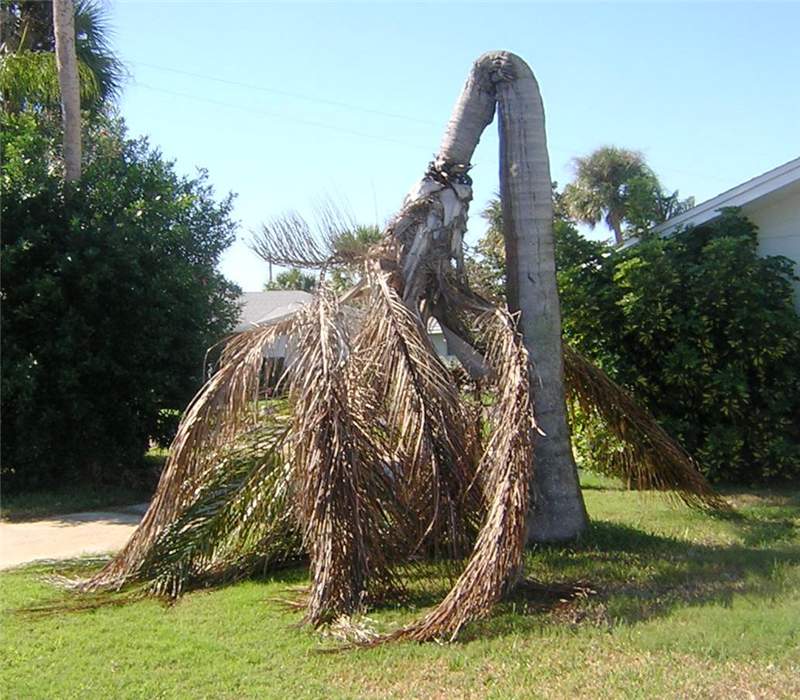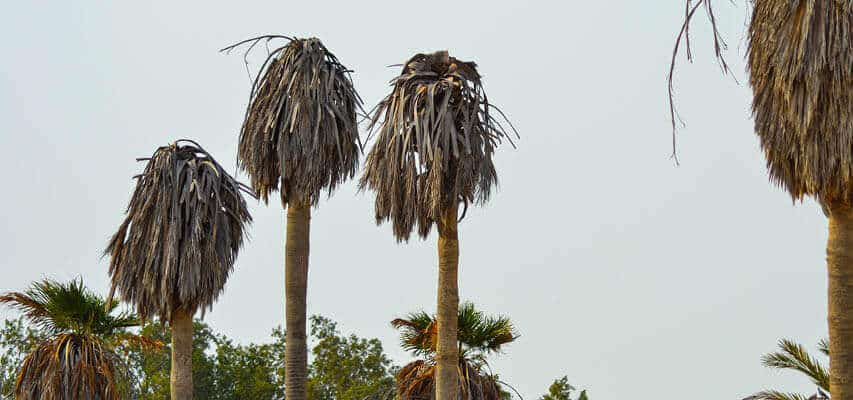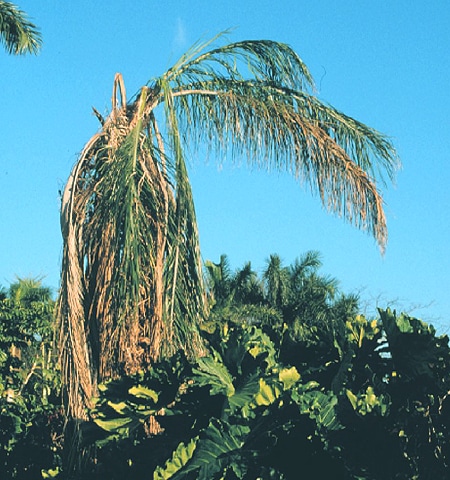Understanding Palm Tree Health: The Basics
Palm trees, with their distinctive silhouette, are not just tropical symbols but also significant landscape features in many environments. Understanding the basics of palm tree health is crucial for anyone looking to maintain these majestic plants. The health of a palm tree can be influenced by a variety of factors, including environmental conditions, soil quality, watering practices, and exposure to pests and diseases. Recognizing the early signs of distress or disease in palm trees can make a significant difference in managing their health effectively.
At the core of palm tree health is the need for a balanced approach to watering, fertilization, and soil management. Palms require well-draining soil to prevent root rot and other water-related diseases. Over-watering or under-watering can lead to stress, making the palm more susceptible to diseases. Nutritional balance is also vital; deficiencies in key minerals can lead to yellowing palm leaves, one of the most common symptoms of an unhealthy palm tree.
Another fundamental aspect of palm tree care is the prevention and treatment of diseases and pests. Types of palm tree diseases vary, but many manifest through visible symptoms such as yellowing or browning of leaves, unusual leaf dropping, and stunted growth patterns. Early detection and appropriate palm disease treatment can prevent more severe damage and help maintain the tree’s health. Additionally, understanding the specific needs and vulnerabilities of the palm species you are caring for can guide more effective maintenance and disease prevention strategies.
By paying attention to these basic aspects of palm tree care, gardeners and landscapers can ensure their palm trees remain healthy and vibrant parts of the landscape. Regular inspection and maintenance, tailored to the specific needs of the palm, are key to preventing disease and ensuring the longevity of these beautiful trees.
Yellowing or Browning of Leaves
One of the most common signs of distress in palm trees is the yellowing or browning of their leaves. This symptom can be indicative of several issues, ranging from nutritional deficiencies to over-watering or under-watering. In many cases, yellowing leaves are a sign that the palm tree is not receiving the right balance of essential nutrients, particularly nitrogen, potassium, and magnesium. These elements are crucial for the health and vitality of a palm tree, and their absence can lead to the discoloration of leaves.
Moreover, improper watering practices can also contribute to the yellowing or browning of palm leaves. Over-watering can lead to root rot, a condition where the roots of the palm tree start to decay due to excessive moisture. This can hinder the tree’s ability to absorb nutrients effectively, leading to yellowing leaves. Conversely, under-watering can cause the tree to dehydrate, resulting in brown, dried-out leaves. It’s important to establish a consistent watering schedule that meets the specific needs of your palm tree, taking into account factors such as the local climate, soil type, and the tree’s size and species.
Addressing the issue of yellowing or browning leaves requires a careful assessment of the tree’s overall care regimen. Ensuring that the palm tree receives the right amount of water and is planted in well-draining soil can help prevent water-related issues. Additionally, supplementing the soil with the appropriate fertilizers can address nutritional deficiencies and promote healthy, green leaves. Regular monitoring and adjustments to the palm tree’s care can help mitigate these symptoms and ensure the longevity and beauty of your palm tree.

Unusual Leaf Dropping
One of the more subtle signs of distress in palm trees is unusual leaf dropping. While it’s natural for palm trees to shed their older leaves, an increase in the frequency or volume of leaf drop can indicate underlying health issues. This symptom often goes unnoticed until a significant number of leaves have been lost, leading to a sparse canopy. Unusual leaf dropping can be triggered by a variety of factors, including environmental stress, improper watering (either too much or too little), nutrient deficiencies, or root damage.
Environmental stress, such as sudden changes in temperature, exposure to extreme cold, or excessive wind, can cause palm trees to lose their leaves prematurely. Similarly, watering issues are common culprits behind leaf drop. Overwatering can lead to root rot, a serious condition that hampers a palm tree’s ability to absorb water and nutrients. Conversely, underwatering can stress the palm, leading to leaf drop as the tree conserves its resources. Nutrient deficiencies, particularly a lack of essential elements like magnesium, potassium, and nitrogen, can also manifest as leaf drop, often accompanied by other symptoms such as yellowing or browning of leaves.
Root damage, whether from physical injury, disease, or pests, can severely affect a palm tree’s health, leading to leaf drop among other symptoms. It’s crucial to carefully inspect the base of the palm and the surrounding soil for signs of damage or disturbance. In cases where root damage is suspected, it’s advisable to seek professional advice to assess the extent of the issue and determine the best course of action.
Addressing unusual leaf dropping early on can prevent more severe damage to the palm tree. Regular inspection, proper watering, and adequate fertilization are key to maintaining palm tree health and preventing leaf drop. If the problem persists, consulting with a professional can help diagnose the issue and recommend specific treatments or care routines.
Visible Signs of Fungus or Mold
Identifying the presence of fungus or mold on your palm trees is crucial for maintaining their health and longevity. These organisms can cause significant damage if left untreated, leading to more severe diseases or even the death of the tree. Visible signs of fungus or mold include a white, powdery substance on the leaves or trunk, black spots or patches, and a general appearance of decay. Fungus thrives in moist conditions, so it’s often found in palms that are overwatered or planted in poorly draining soil.
Types of palm tree diseases associated with fungus include Ganoderma butt rot, which is characterized by a shelf-like growth at the base of the palm, and Fusarium wilt, which causes fronds to turn yellow and die. Both diseases are serious and can lead to the eventual death of the palm if not addressed promptly. Treatment for fungal infections may involve removing affected parts of the tree, applying fungicides, and correcting care practices to prevent future outbreaks.
Palm tree care to prevent fungal growth includes ensuring proper drainage, avoiding overwatering, and cleaning up leaf debris around the base of the tree. It’s also important to sterilize pruning tools between uses to prevent the spread of spores. Regular inspection of your palm trees can help catch signs of fungus or mold early, making treatment more effective and saving your palms from irreversible damage.
Understanding the signs of fungus or mold and taking immediate action can protect your palm trees from serious health issues. By providing the right care and conditions, you can enjoy the beauty and benefits of healthy palm trees for years to come.

Pest Infestations and Their Impact
Pest infestations can severely impact the health and longevity of palm trees, often manifesting through various distressing symptoms. Recognizing these signs early can be crucial in managing and mitigating the damage caused by pests. Common pests that target palm trees include palm weevils, scale insects, and spider mites, each presenting unique challenges and symptoms.
Palm weevils, for instance, are notorious for their destructive larvae, which burrow into the heart of palm trees, causing internal damage that can lead to the tree’s death. Signs of weevil infestation include holes in the trunk, a fermented smell emanating from the tree, and fronds that collapse or droop unexpectedly.
Scale insects, on the other hand, attach themselves to the leaves and stems of palm trees, sucking the sap and weakening the plant. These pests are visible as small bumps on the surfaces of leaves and stems, often accompanied by a sticky substance known as honeydew, which can lead to the growth of sooty mold on the leaves.
Spider mites cause damage by feeding on the undersides of palm leaves, leading to yellowing, browning, and eventual leaf drop. These pests are tiny and may require a magnifying glass to be seen, but the fine webbing they produce on the leaves can be a telltale sign of their presence.
Addressing pest infestations promptly with appropriate palm disease treatment methods is essential for the health of the tree. This may include the application of insecticides, biological control methods, or cultural practices designed to make the environment less hospitable to pests. Regular inspection and maintenance are key to preventing infestations and ensuring the long-term health of palm trees.
Pest Infestations and Their Impact
Pest infestations can severely impact the health and longevity of palm trees, often being a primary contributor to their decline. Recognizing the signs of pest infestation is crucial for early intervention and management. Common pests that target palm trees include palm weevils, spider mites, and scale insects. These pests not only damage the palm by feeding on its tissues but can also introduce diseases, further compromising the tree’s health.
Palm weevils, for instance, bore into the trunk, causing internal damage that can lead to the tree’s collapse. Symptoms of their presence include holes in the trunk, a fermented smell, and the oozing of sap. Spider mites, though tiny, can cause significant damage by sucking sap from the leaves, leading to yellowing palm leaves, one of the critical LSI keywords indicating palm tree distress. Scale insects, on the other hand, attach themselves to the leaves and stems, sucking the sap and weakening the tree. A heavy infestation can coat the leaves with a sticky substance known as honeydew, which can lead to the growth of sooty mold.
Addressing pest infestations involves a combination of cultural, biological, and chemical controls. Regular inspection of palm trees is essential for early detection of pests. Biological control methods, such as introducing natural predators of the pests, can be an effective and environmentally friendly option. In severe cases, chemical treatments may be necessary. However, it’s crucial to use them judiciously to avoid harming beneficial organisms or causing environmental damage.
Understanding the types of palm tree diseases and their associated pests, as well as implementing effective palm disease treatment strategies, is key to maintaining healthy palm trees. By staying vigilant and adopting proactive palm tree care measures, gardeners and landscapers can protect their palm trees from the devastating impacts of pest infestations.

Preventative Measures for Maintaining Palm Tree Health
Maintaining the health of your palm trees is crucial to prevent the onset of diseases and pest infestations. A proactive approach to palm tree care can significantly reduce the risk of common issues associated with palm tree health. Here are several preventative measures you can take to ensure the longevity and vitality of your palm trees.
Firstly, it’s essential to select the right location for planting your palm trees. Ensure the area has adequate sunlight and is well-drained to prevent waterlogging, which can lead to root rot. Understanding the specific needs of the type of palm tree you are planting is also critical, as different species have varying requirements for sunlight, water, and soil type.
Regular watering is vital, especially for young trees. However, overwatering can be detrimental, so it’s important to allow the soil to dry out between watering sessions. Implementing a consistent fertilization schedule is also key to providing your palm trees with the necessary nutrients they need to thrive. Use a palm-specific fertilizer that contains the right balance of nitrogen, potassium, and magnesium.
Pruning is another important aspect of palm tree care. Remove dead or dying fronds to help prevent the spread of disease and pests. However, avoid over-pruning or trimming too close to the trunk, as this can cause unnecessary stress to the tree.
Finally, regular inspection of your palm trees can help catch early signs of disease or pest infestation. Early detection is crucial for effective treatment. Look out for changes in leaf color, unusual leaf dropping, or signs of fungus and mold. If you notice any of these symptoms, taking immediate action can help save your palm tree and prevent the issue from spreading to other nearby plants.
By following these preventative measures, you can help ensure your palm trees remain healthy and vibrant for years to come.
The Importance of Regular Inspection and Maintenance
Regular inspection and maintenance are crucial for the health and longevity of palm trees. These practices not only help in identifying the early signs of palm tree diseases but also play a significant role in preventing them. By conducting routine checks, you can spot the early symptoms of palm tree diseases, such as yellowing palm leaves, unusual leaf dropping, or the presence of pests, before they escalate into more severe problems.
Inspection should include a thorough examination of the leaves, trunk, and the area surrounding the tree. Look for any visible signs of distress or disease, including changes in leaf color, texture, or the appearance of spots, which could indicate types of palm tree diseases. Additionally, checking the soil moisture and the overall stability of the tree can provide insights into its health. Maintenance involves proper watering, fertilization, and pruning practices that are essential for palm tree care. Over or under-watering can lead to stress on the tree, making it more susceptible to diseases. Similarly, incorrect fertilization can harm the tree’s health. Pruning, when done correctly, can remove diseased or dead parts of the tree, preventing the spread of disease.
Furthermore, regular maintenance helps in creating an unfavorable environment for pests, which are often carriers of diseases. By removing dead leaves and debris from around the tree, you reduce the risk of pest infestations, thereby protecting the tree from potential harm. In essence, the key to healthy palm trees lies in the proactive approach of regular inspection and maintenance. This not only aids in early detection of palm disease treatment but also ensures the vibrant growth and longevity of your palm trees.
When to Call a Professional: Seeking Expert Advice
Identifying the signs of palm tree disease early can be crucial in saving your palm trees and preventing the spread of disease to other healthy trees in the vicinity. While many palm tree symptoms can be managed with proper care and treatment, there are instances when calling a professional is the best course of action. Knowing when to seek expert advice is essential for the health and longevity of your palm trees.
Firstly, if you’ve applied the recommended palm disease treatment based on the symptoms observed and have not seen any improvement within a few weeks, it might be time to consult a professional. Experts in palm tree care have the experience and tools to diagnose issues that might not be apparent to the untrained eye. They can offer more targeted treatments or suggest alternative solutions.
Secondly, if the palm tree shows signs of advanced disease, such as extensive yellowing palm leaves, significant leaf drop, or visible damage to the trunk, professional intervention may be necessary. Some types of palm tree diseases can progress rapidly and require specialized treatment methods that are not readily available to the general public.
Additionally, if you are unsure about the specific type of palm tree you have or the diseases it’s susceptible to, a professional can provide valuable insights. Different types of palm trees may require different care approaches, and what works for one species may not be suitable for another.
In conclusion, while many aspects of palm tree care can be managed independently, there are situations where the expertise of a professional is invaluable. By recognizing when to call in the experts, you can ensure that your palm trees receive the best possible care and continue to thrive for years to come.
Conclusion: Protecting Your Palm Trees for the Future
Ensuring the health and longevity of your palm trees is an ongoing commitment that requires attention, care, and sometimes, the intervention of professionals. Recognizing the signs of palm tree disease early on is crucial for the successful treatment and recovery of these majestic plants. Symptoms such as yellowing palm leaves, unusual leaf dropping, stunted growth patterns, visible signs of fungus or mold, and pest infestations are clear indicators that your palm tree is in distress. Understanding these palm tree symptoms and knowing how to respond is essential for any palm tree caretaker.
Preventative measures, including proper watering, fertilization, and pruning practices, play a significant role in maintaining palm tree health. Regular inspection and maintenance not only help in early detection of potential issues but also enhance the natural beauty and longevity of your palms. However, it’s important to recognize when a situation is beyond your expertise. In cases of severe palm disease treatment or when you’re unsure about the type of palm tree diseases affecting your plant, seeking expert advice becomes imperative.
Professionals in palm tree care have the knowledge, tools, and experience to diagnose and treat diseases effectively, ensuring the best possible outcome for your trees. By taking proactive steps towards understanding and addressing the needs of your palm trees, you contribute to a healthier environment and ensure that these iconic symbols of tropical beauty thrive for future generations to enjoy.
